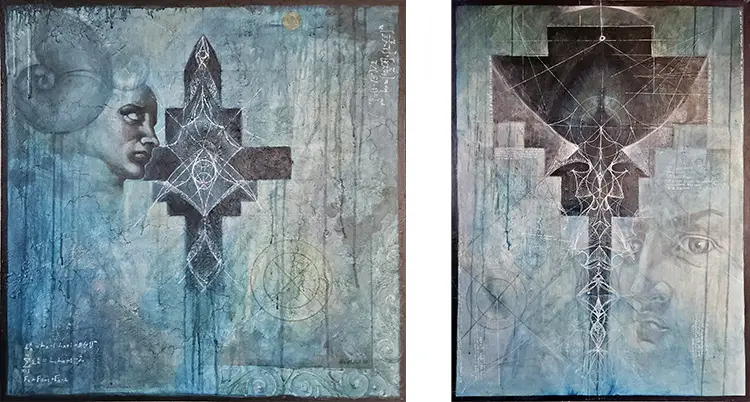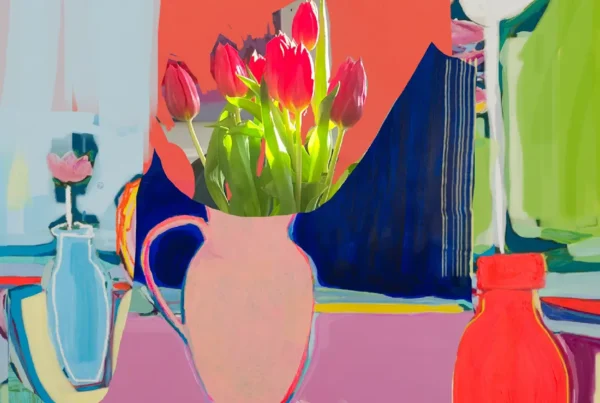“All of my works represent a bridge between centuries, continents, and cultures and explore temporal constructs, historical context, scientific exploration, and the natural and ethereal world.”
Woven Through Continents: A Life in Motion, A Practice in Transition
Juliette Pelletier’s artistic narrative is inseparable from the global map etched by her life. Born in Toronto and raised amidst the vivid cultures of eight countries across five continents, she developed a worldview shaped not by boundaries, but by movement. These formative migrations offered her an early education in contrast and commonality, exposing her to the nuances of visual traditions that transcend language and location. From the outset, art became more than expression—it became translation, bridge, and mirror. Her academic path led her to Parsons School of Design in Paris, where she earned a Bachelor of Fine Arts with a minor in Art History. Further immersion in classical technique followed at the École Nationale Supérieure des Beaux-Arts, where she deepened her skills in drawing and painting, anchoring her future work in both historical discipline and conceptual breadth.
Since 1999, Pelletier has called New York City home, though her life now straddles the distinct environments of South Bronx and Tucson, Arizona. This dual residency mirrors her practice: simultaneously grounded in contemporary discourse and open to expansive natural philosophies. Her work has been featured internationally for more than 25 years, culminating in opportunities such as the Sichuan University Artist in Residence Program in Chengdu, China, and, more recently, a residency at the Château d’Orquevaux in France. In addition to her studio practice, Pelletier has spent two decades shaping the art world behind the scenes—as a curator, gallery director, and advocate for artists. She founded Juliette Solutions LLC in 2018 to provide mission-driven services in events, marketing, and development for creatives and nonprofits globally.
Her artistic output is undeniably shaped by the synthesis of these personal, academic, and professional layers. In her hands, art becomes a lens through which memory, identity, and displacement are examined. The rhythm of cities and the stillness of landscapes both feed her process, producing work that embodies the push and pull of progress and preservation, structure and erosion. Whether collaborating with international institutions or working alone in her studio, Pelletier carries her layered experience into every line, color, and compositional decision, allowing her pieces to speak of places both lived and imagined.
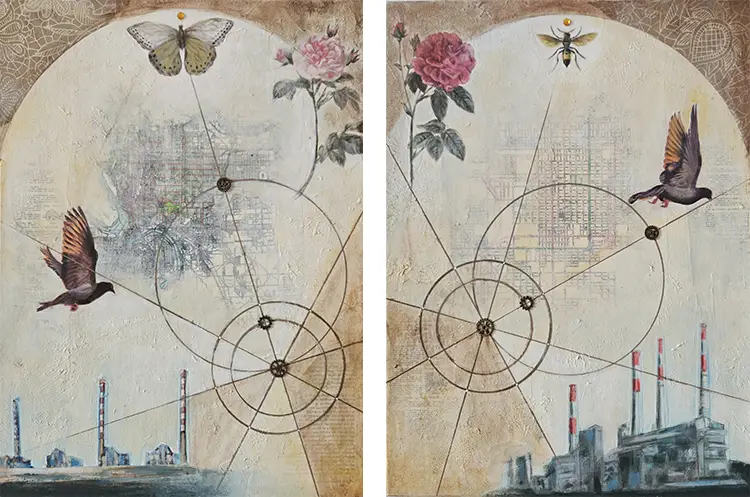
Involuntary Migration 1, 2025
Involuntary Migration 2, 2025
Juliette Pelletier: Structure, Symbolism, and the Echoes of Time
Pelletier’s creative style balances classical refinement with conceptual depth, offering a visual language that connects centuries and ideologies. Her compositions often integrate surrealistic gestures, painterly abstraction, and technical draftsmanship, creating a dialogue between illusion and intention. Through this multifaceted approach, she interrogates temporal and spatial constructs—constructs that are continually shaped by history, science, and nature. Her work is divided into four ongoing series—Entropy and Intent, Monoliths, Historical Chronicles, and her current focus, Encroachment. Each series acts as a chapter in her evolving investigation of how humans exist in and against the forces of time, space, and environment.
The Encroachment series, in particular, carries personal and ecological urgency. Initiated in 1998 and revisited only recently, this body of work reflects Pelletier’s longstanding concern with the tension between urban expansion and environmental degradation. Using paper collage on canvas, integrated with acrylics, sumi ink, sand, and other mixed media, she constructs surfaces that feel both archaeological and futuristic. This layering technique builds not only texture but metaphor—offering viewers a multidimensional representation of the fragility and strength of ecosystems, human systems, and their inevitable intersections. At the heart of these works lies a compass motif, a recurring symbol representing autonomy and orientation amidst dislocation and change.
Beyond the imagery, underlying structures in Pelletier’s pieces often follow the proportions of the Fibonacci sequence and golden ratio. These mathematical frameworks—found in everything from nautilus shells to galaxies—serve as compositional anchors, suggesting that the same forces organizing the cosmos also shape human experience. By grounding her visual vocabulary in these universal patterns, she reminds the viewer of an interconnectedness that surpasses the anthropocentric gaze. Her art becomes not only an aesthetic experience but a philosophical meditation, where each line and fragment points to the complex systems—natural, historical, and psychological—that inform our reality.
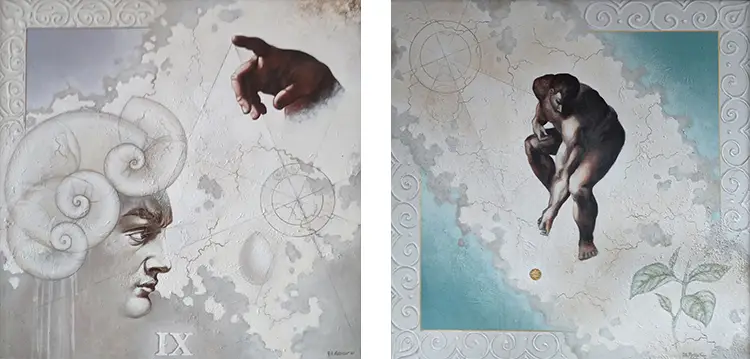
Day IX, 2005
Macrocosmic Tug, 2005
Continuity Through Influence: Past as Present in the Studio
Pelletier draws inspiration from across centuries and civilizations, viewing art history not as a timeline but as an ever-evolving conversation. Her early fascination with the cave paintings of Lascaux—a primal testament to humanity’s desire to record its existence—continues to inform her understanding of visual language as a form of survival and legacy. From the Renaissance, she embraces the drama and rigor found in the works of Caravaggio and Leonardo da Vinci, whose masterful techniques and conceptual clarity still resonate in her own commitment to structure and symbolism. Equally compelling are the vibrant palettes and emotive gestures of the Impressionists, whose approach to light and atmosphere find echoes in her more abstracted moments.
Her curatorial and academic background further deepens her intellectual engagement with the art world. Pelletier’s tenure directing the Merton D. Simpson Gallery of Tribal Art significantly shaped her appreciation for African and Oceanic art, which she acknowledges as having profoundly influenced modernist movements. These traditions, often underrecognized in mainstream narratives, provide her with a rich source of aesthetic language and spiritual depth. The artifacts and symbols within these cultures surface subtly in her works, contributing to their layered content and cross-cultural resonance. This multidimensional influence allows her to simultaneously honor tradition and critique systems of dominance, particularly as they relate to environmental and cultural histories.
Pelletier’s studio itself is an evolving archive of books, critical writings, and visual references. Whether working at home or within the solitude of a residency, she surrounds herself with objects and texts that provoke inquiry and sustain focus. Her process, while grounded in formal technique, is driven by intellectual curiosity and emotional memory. Despite her administrative responsibilities with Juliette Solutions LLC, which often divert her time and attention, she cultivates a sense of discipline and inner quiet to protect her creative flow. Within this carefully constructed space, the artist continues her dialogue with history, nature, and self—always seeking alignment between intention and form.
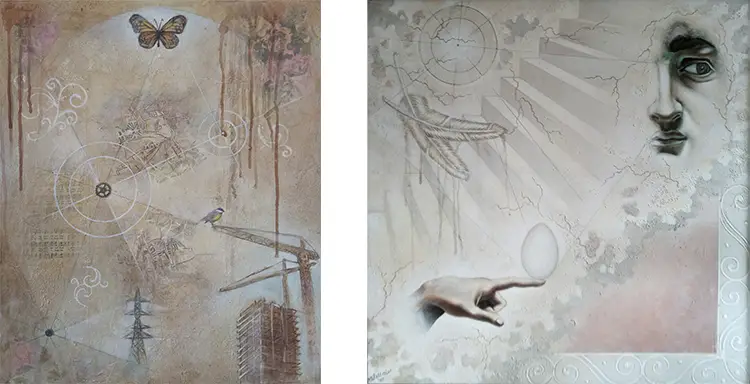
Butterfly Effect – Encroachment 2, 2024
Primeval Wisdom, 2005
Juliette Pelletier: Living the Process, Building the Vision
The evolution of Pelletier’s practice is marked by its responsiveness to environment and circumstance. Her studio setups have ranged from modest corners in small apartments to expansive spaces offered through residencies. Today, her home studio is a dedicated area anchored by two large worktables, and she plans to add an easel to further accommodate her growing body of work. What remains consistent, regardless of scale or location, is her intentional arrangement of space—designed not only for productivity but for immersion. Good lighting, accessible tools, and a flexible layout allow her to maintain momentum, while also providing the mental quietude necessary for sustained focus and experimentation.
Despite the constant demands of running a consultancy firm, Pelletier finds refuge in the act of creating. When she is engaged with her materials, distractions naturally recede, allowing her to enter a state of concentrated presence. This flow state, though elusive at times, forms the foundation of her artistic renewal. The balance between business and creativity requires vigilance and self-awareness, yet she views this dynamic as part of her broader commitment to the arts. By building structures that support other artists while nurturing her own creative output, she embodies the interconnectedness that her artworks so often depict.
With the Encroachment series, Pelletier is finally realizing a long-held vision. First conceptualized in 1998 and set aside for decades, this project has re-emerged with urgency and clarity. Her recent residency at Château d’Orquevaux provided the space, stillness, and inspiration necessary to refine the direction of the series. Removed from routine obligations, she reconnected with the thematic weight of the work—its exploration of humanity’s evolving impact on nature—and began building a visual language that communicates both warning and wonder. Through this ongoing series, Pelletier continues to articulate a vision that is as personal as it is planetary, shaped by years of reflection, movement, and an unwavering devotion to the art of inquiry.
